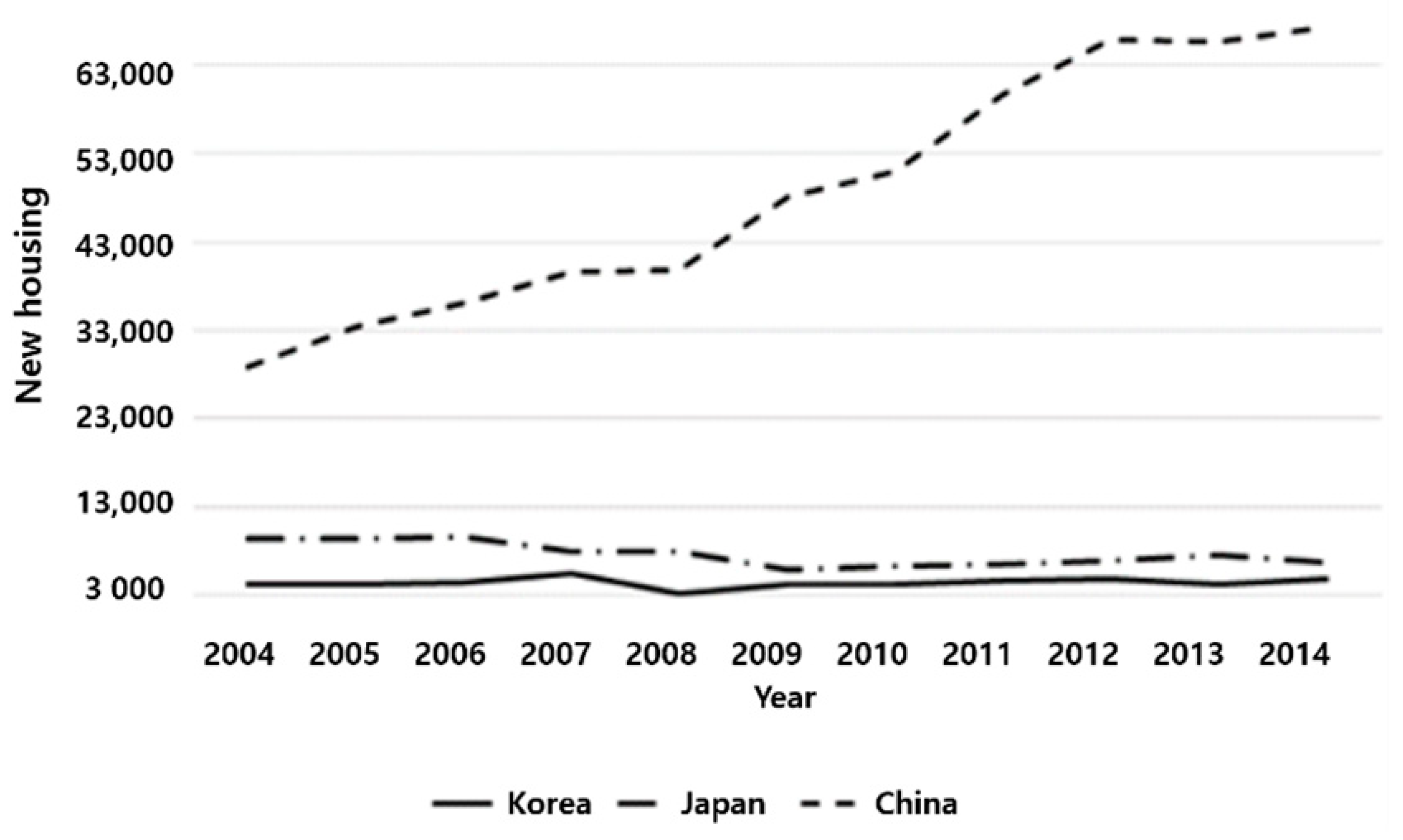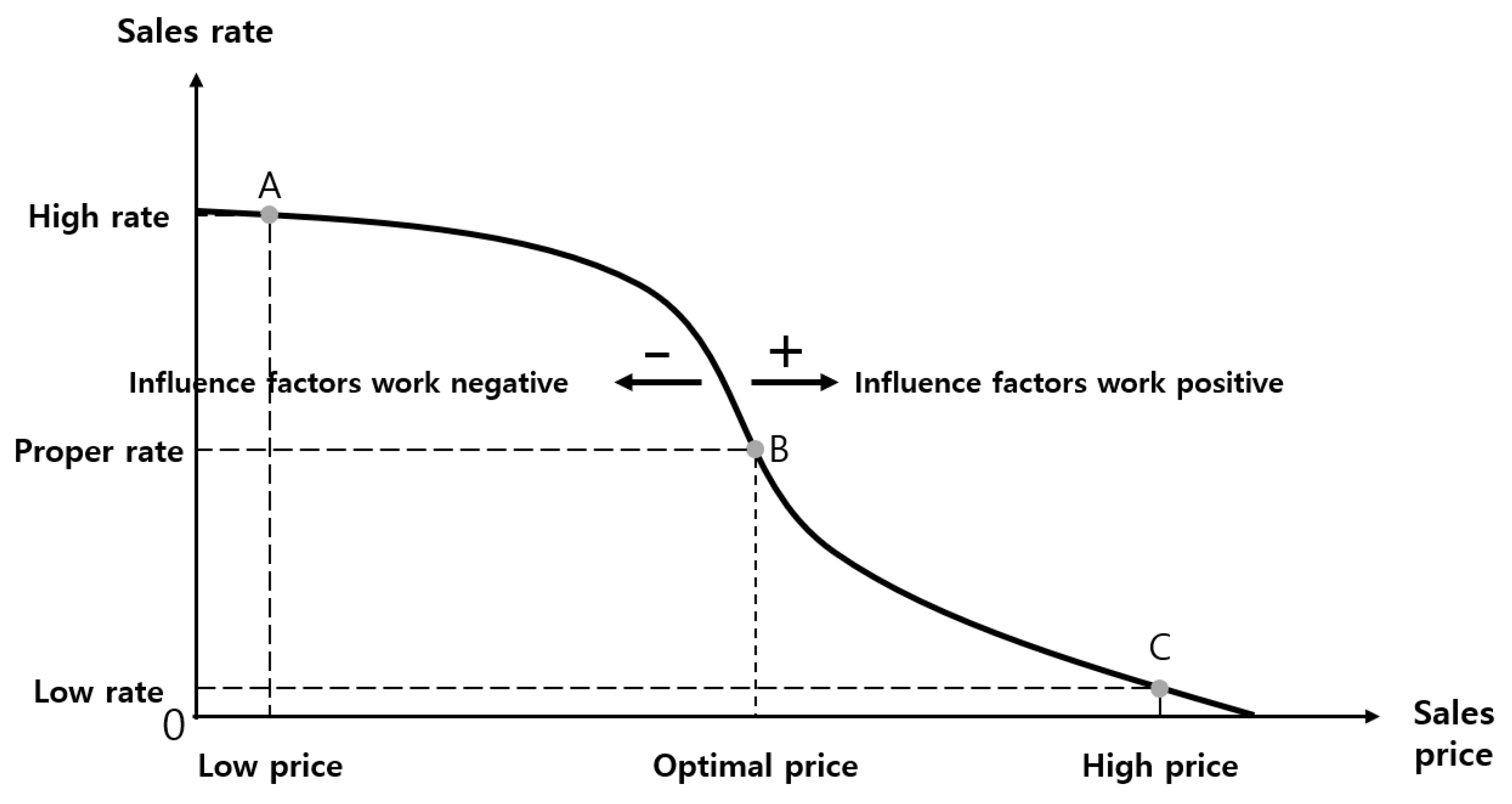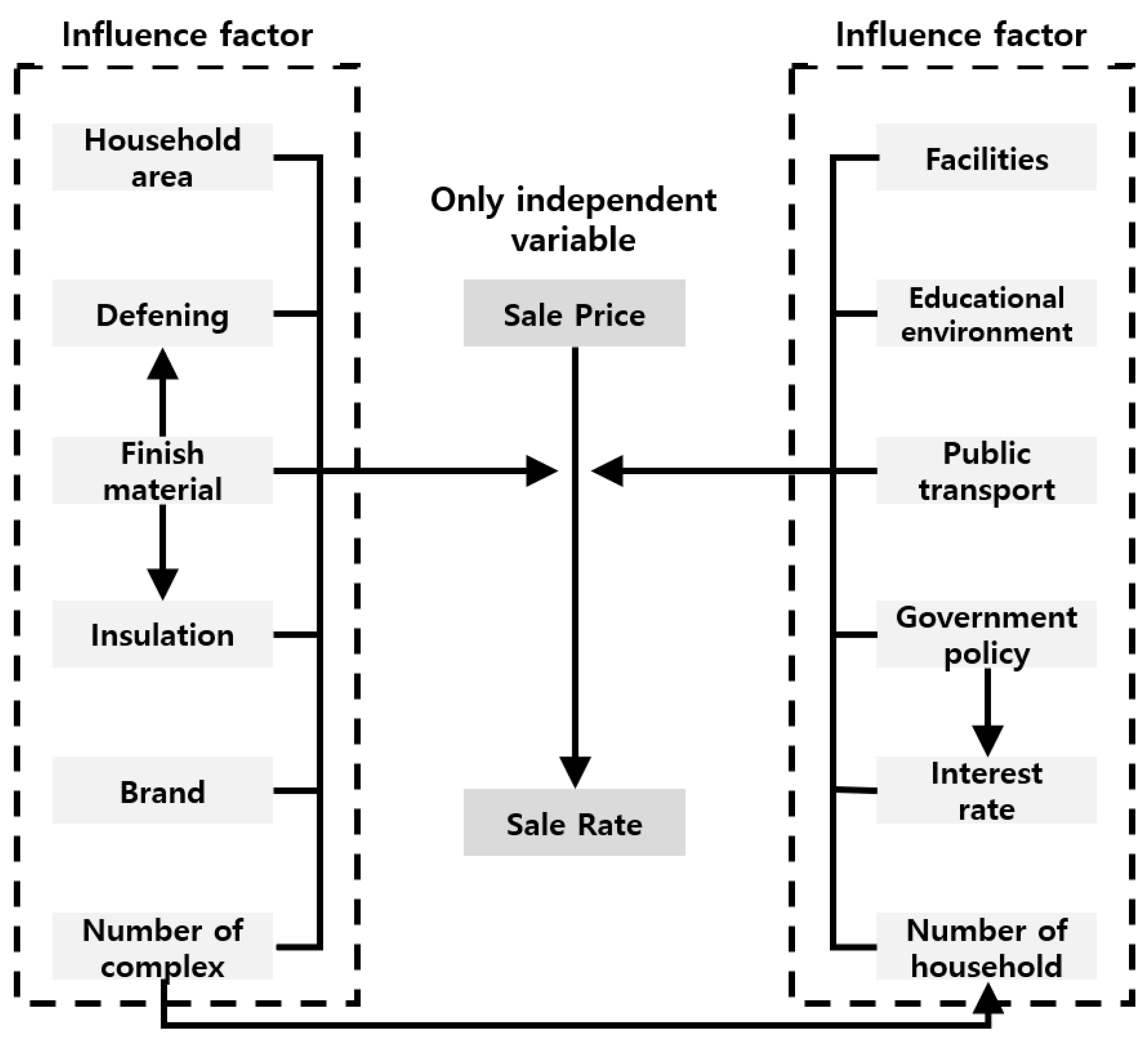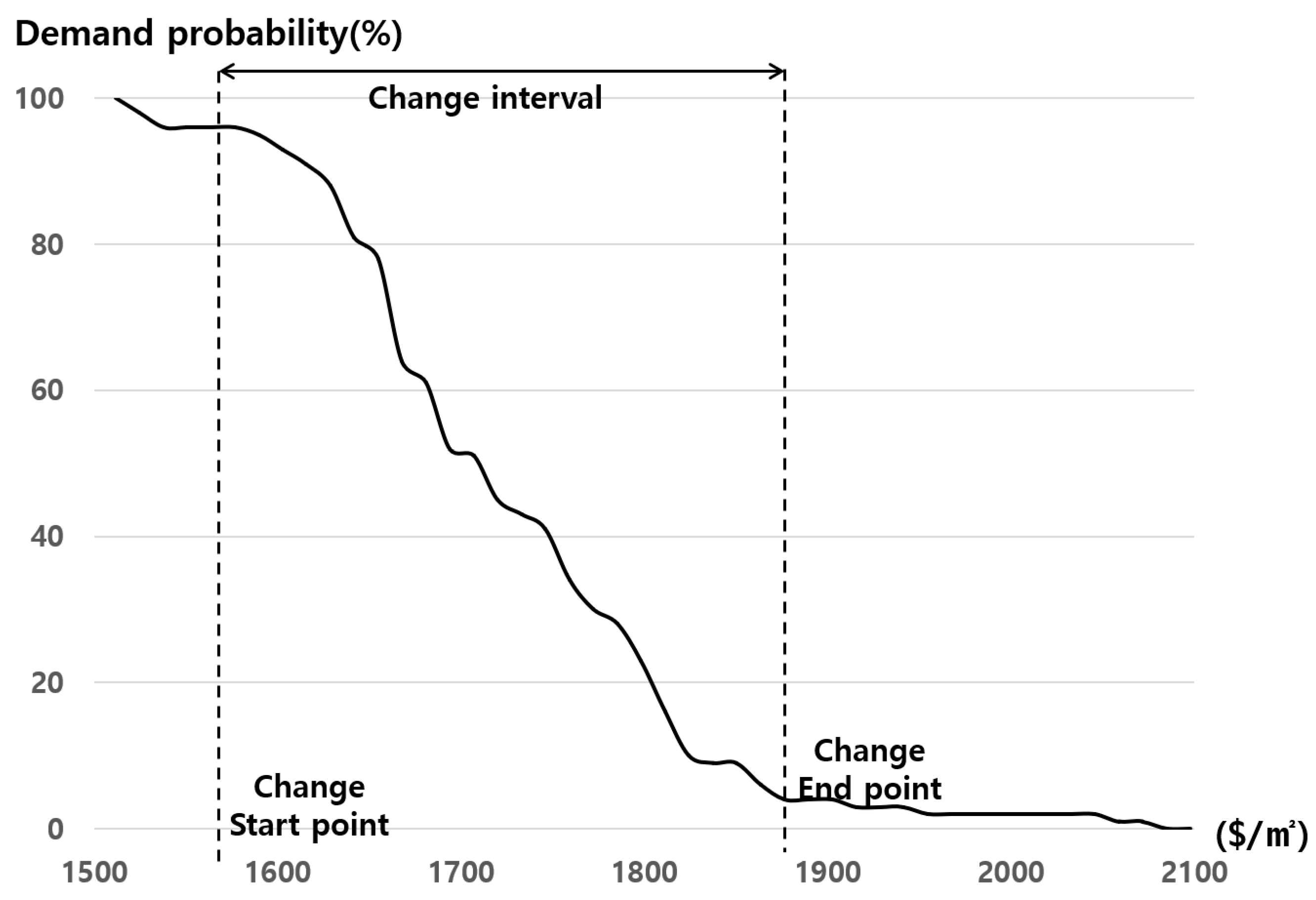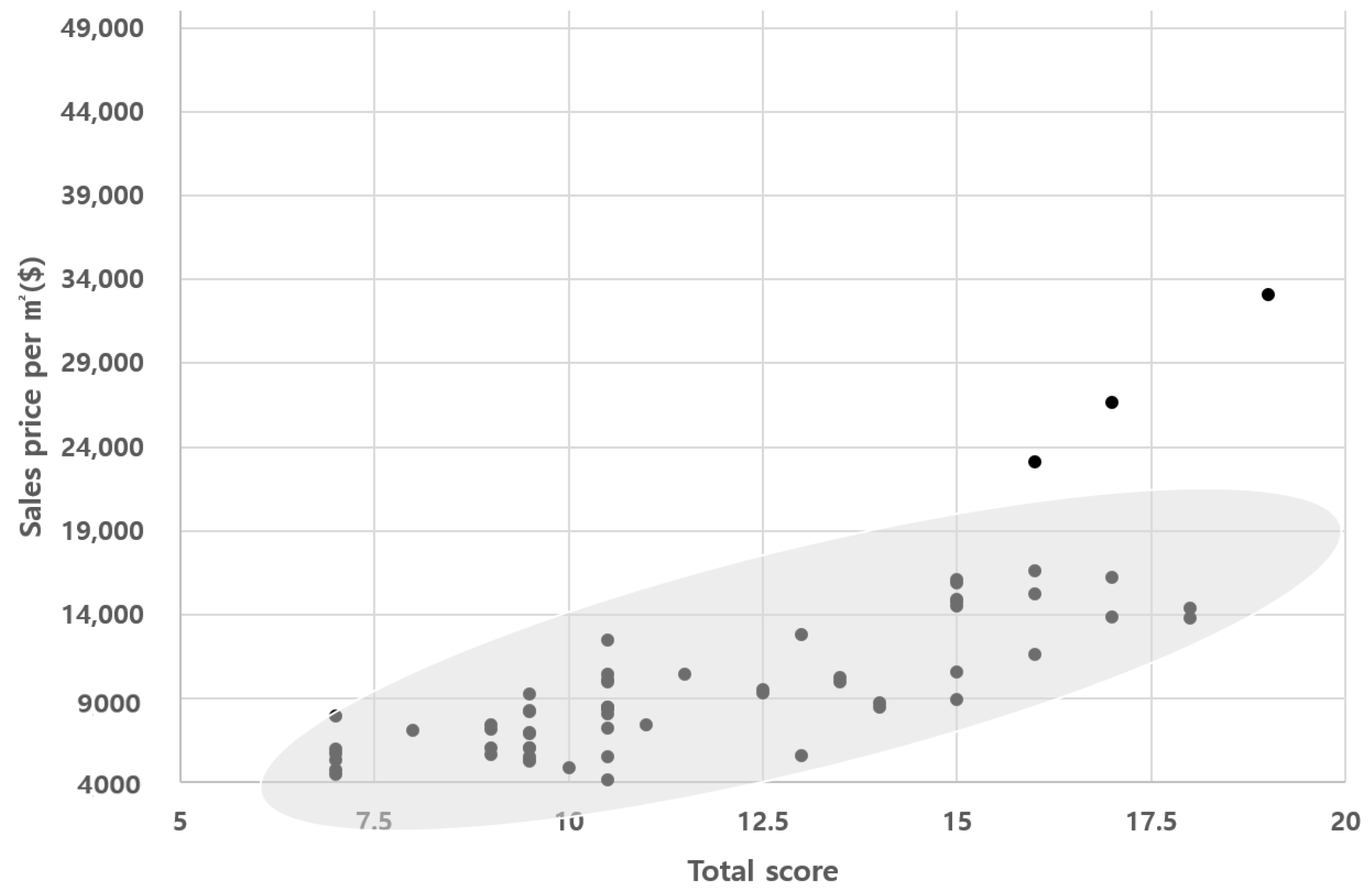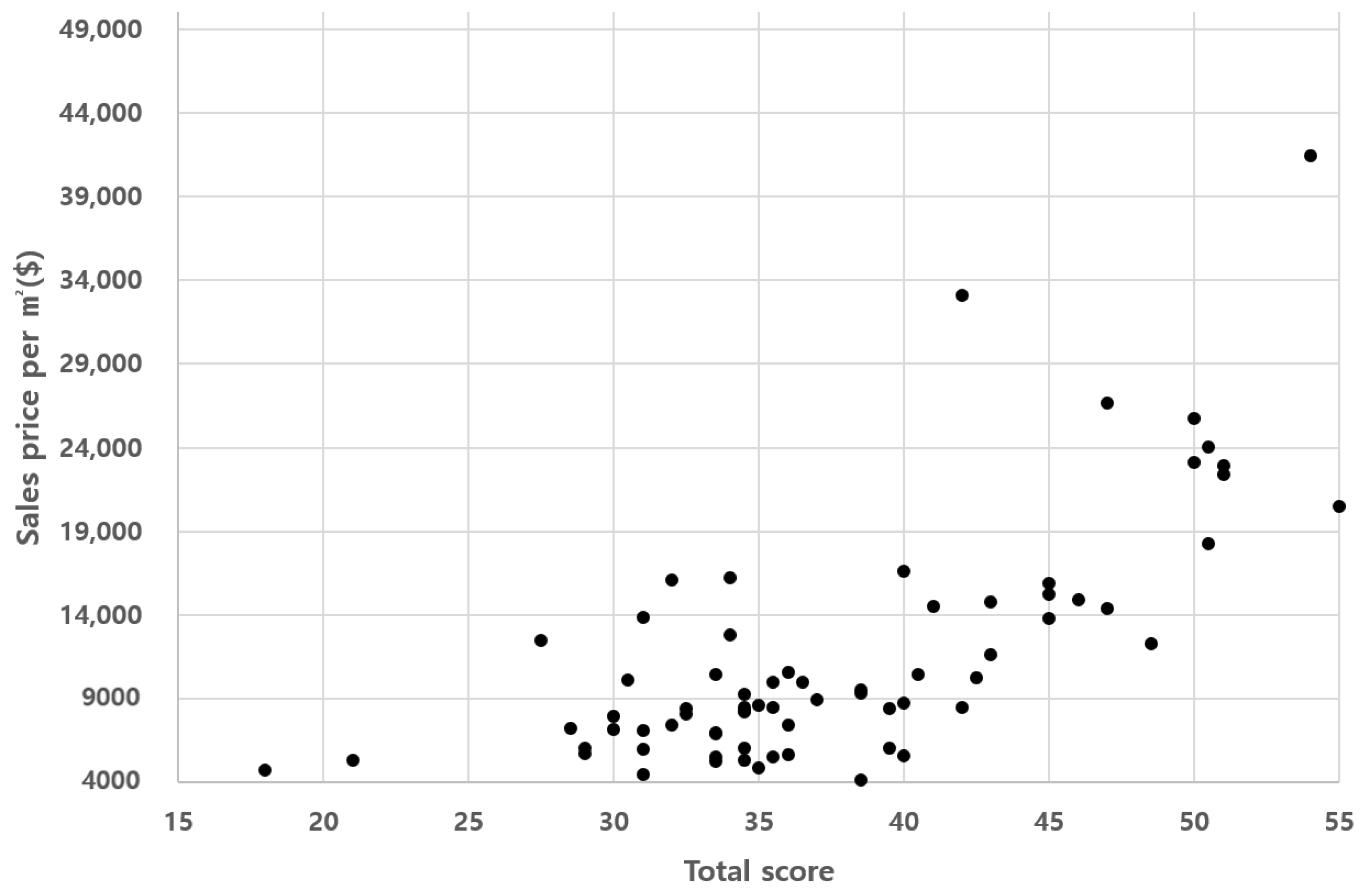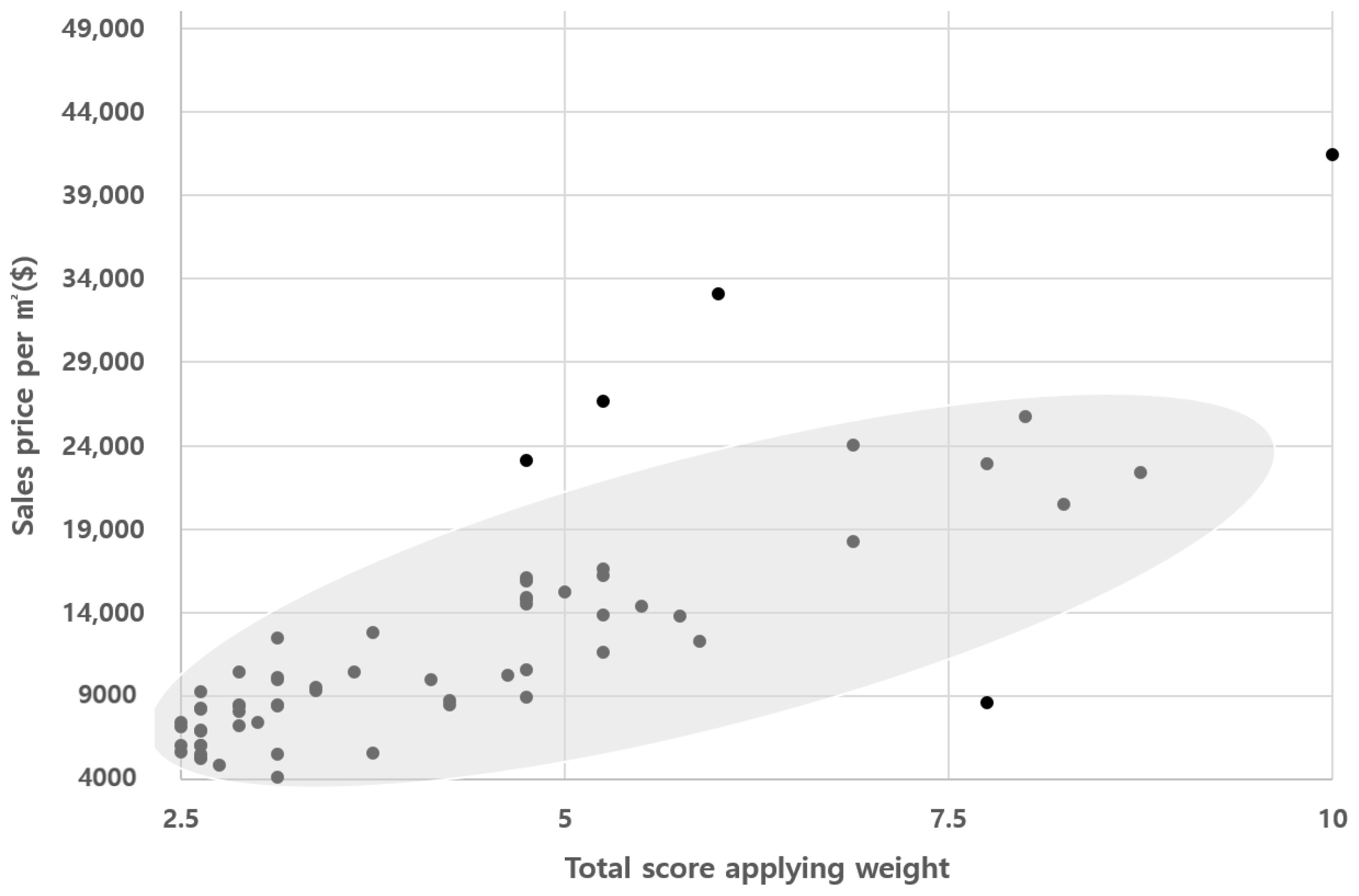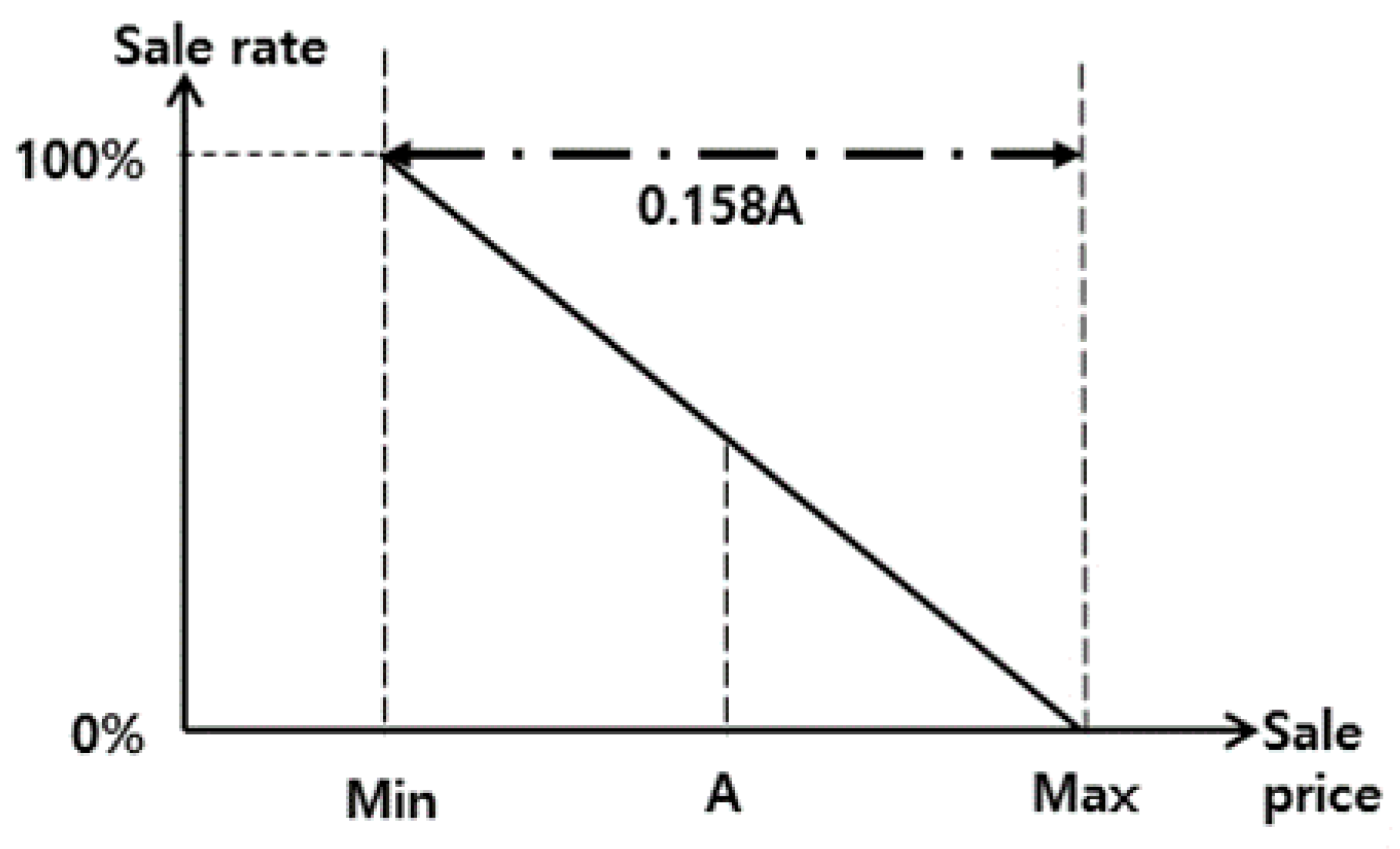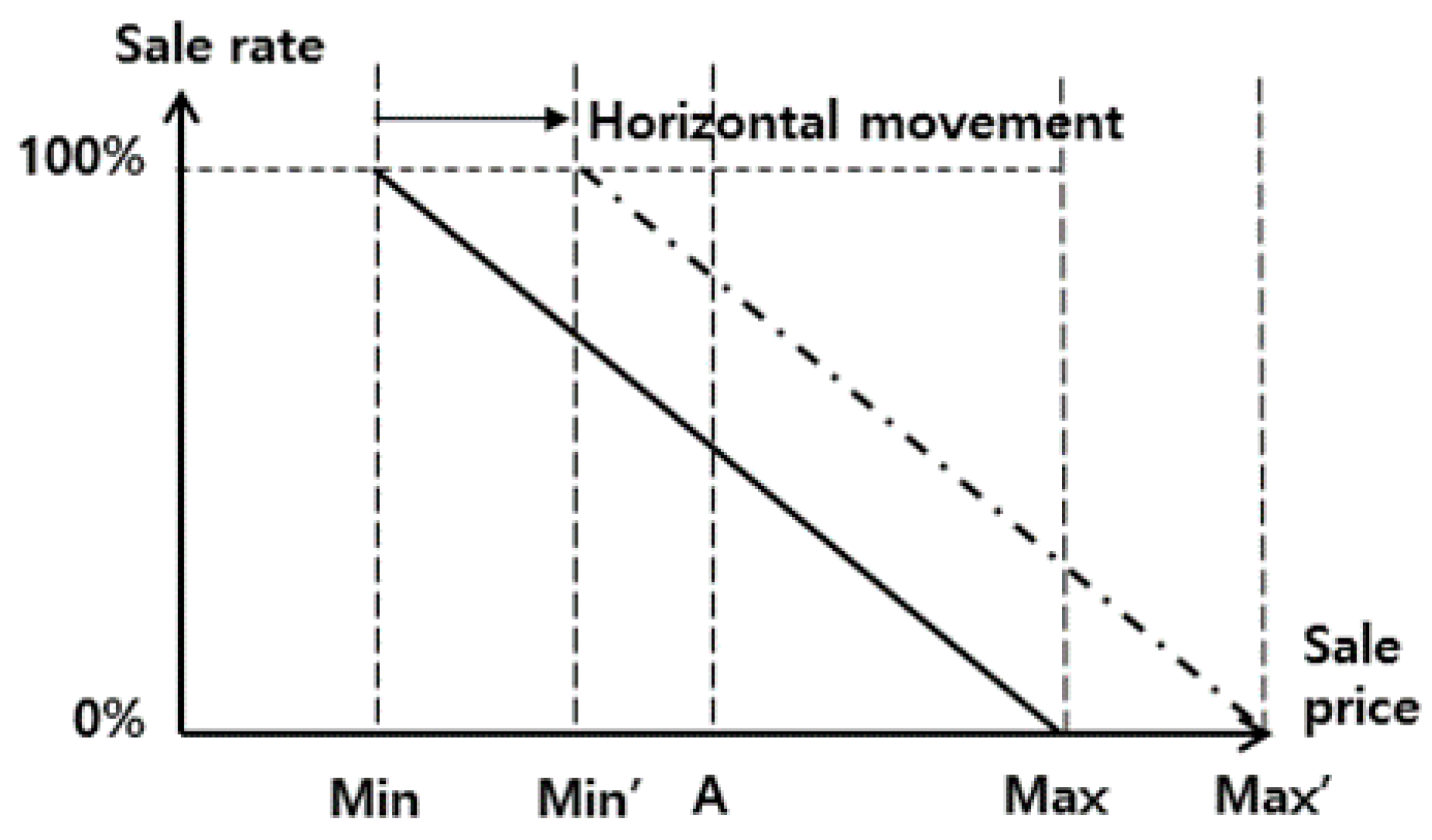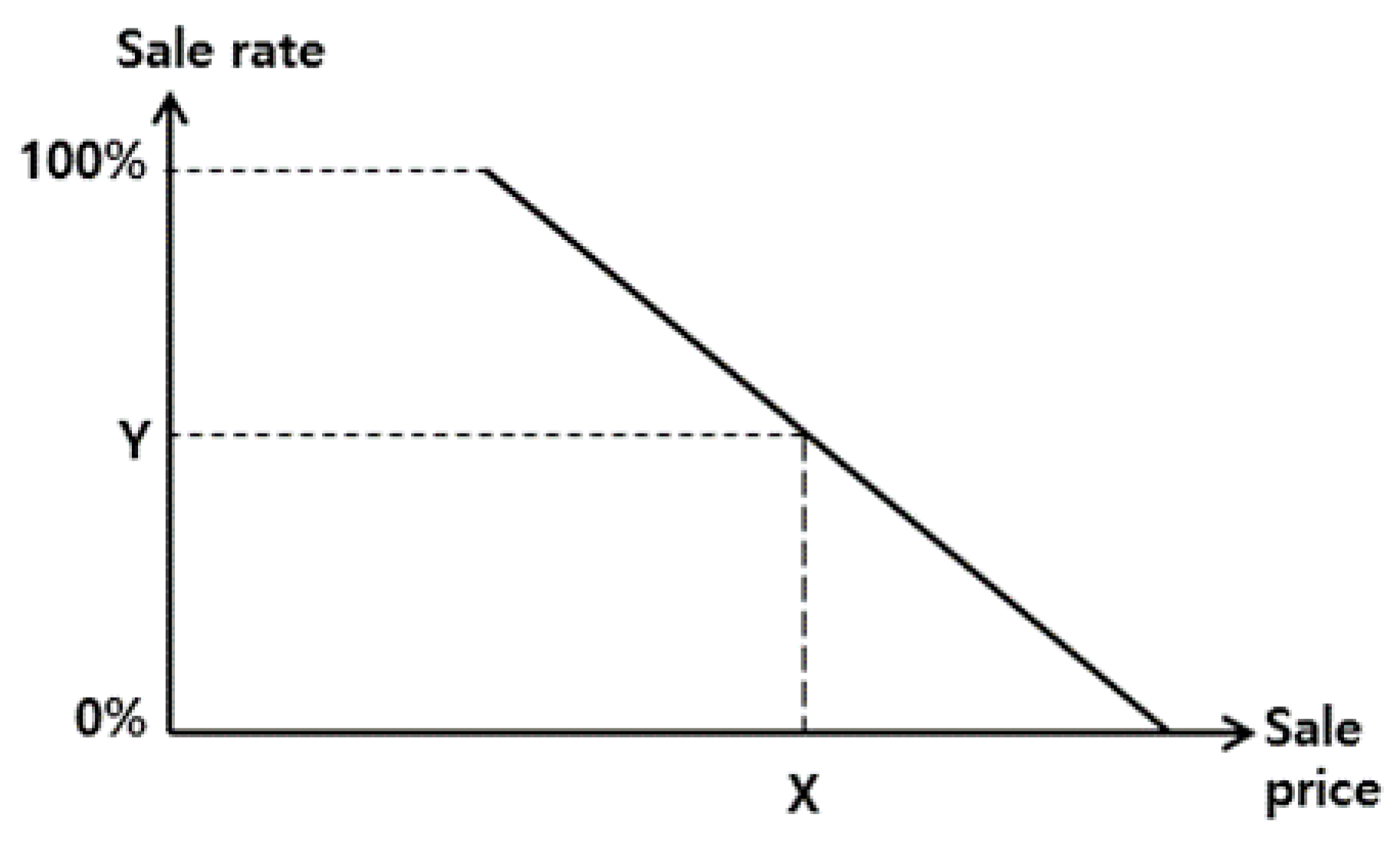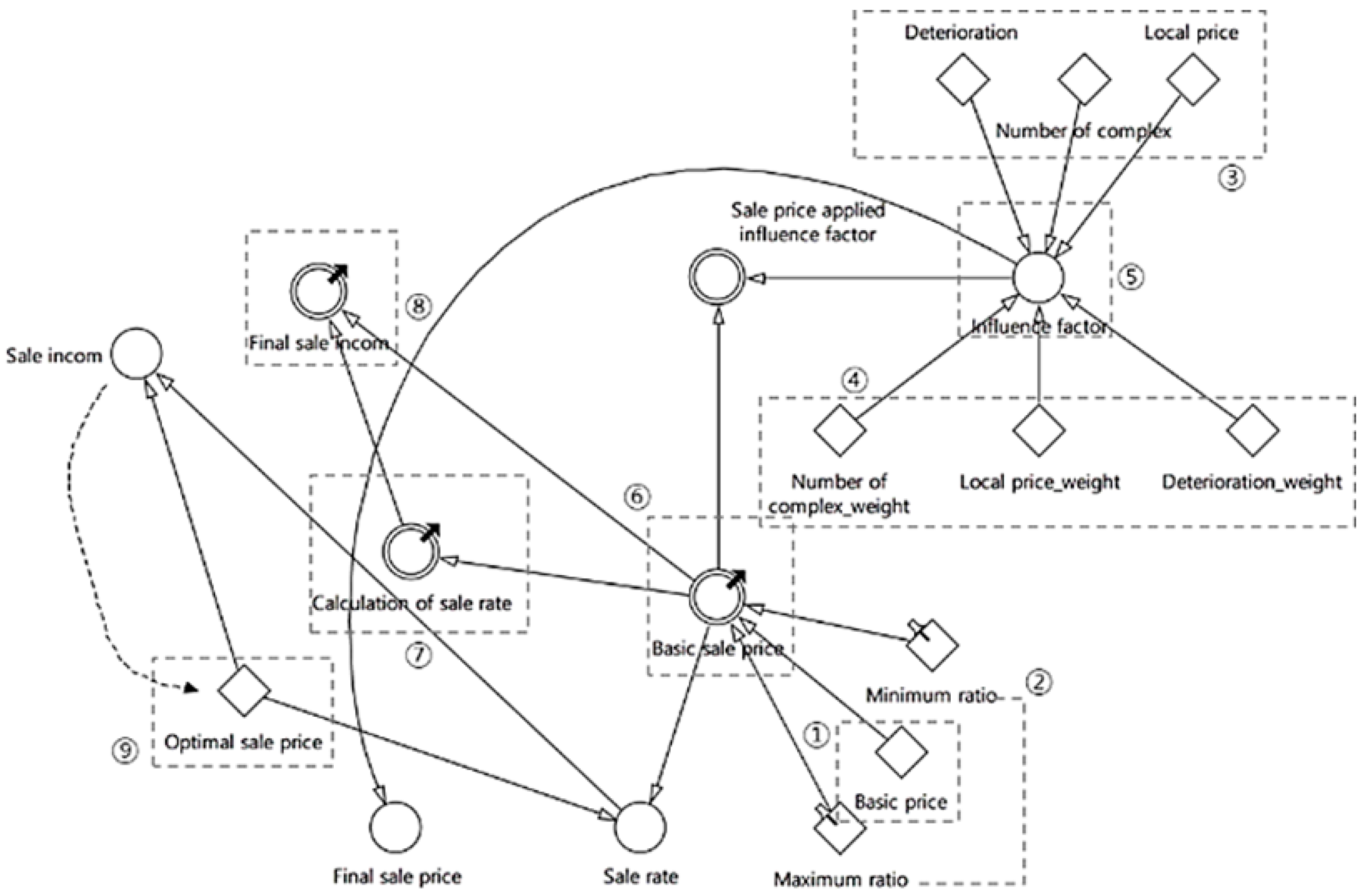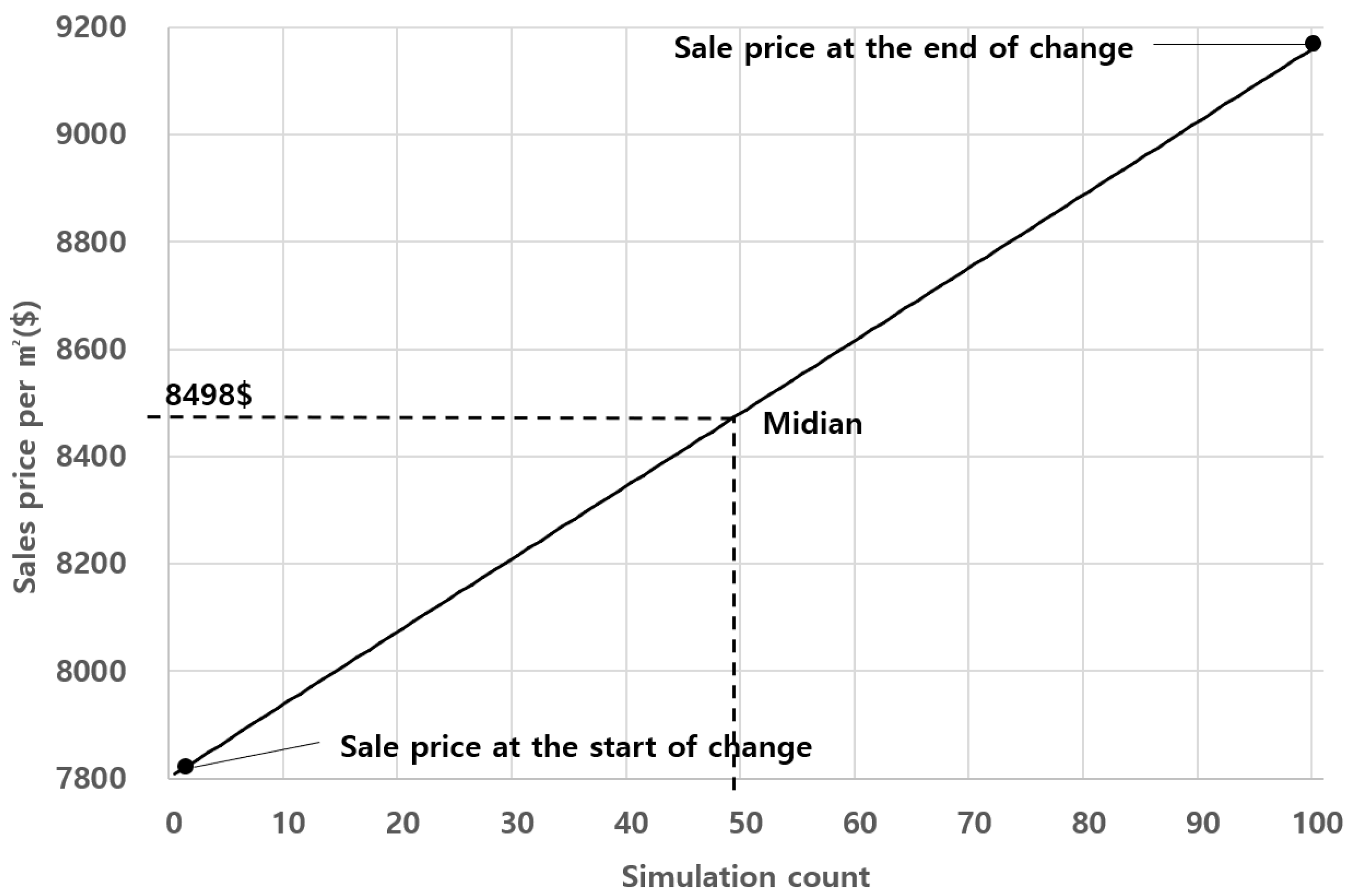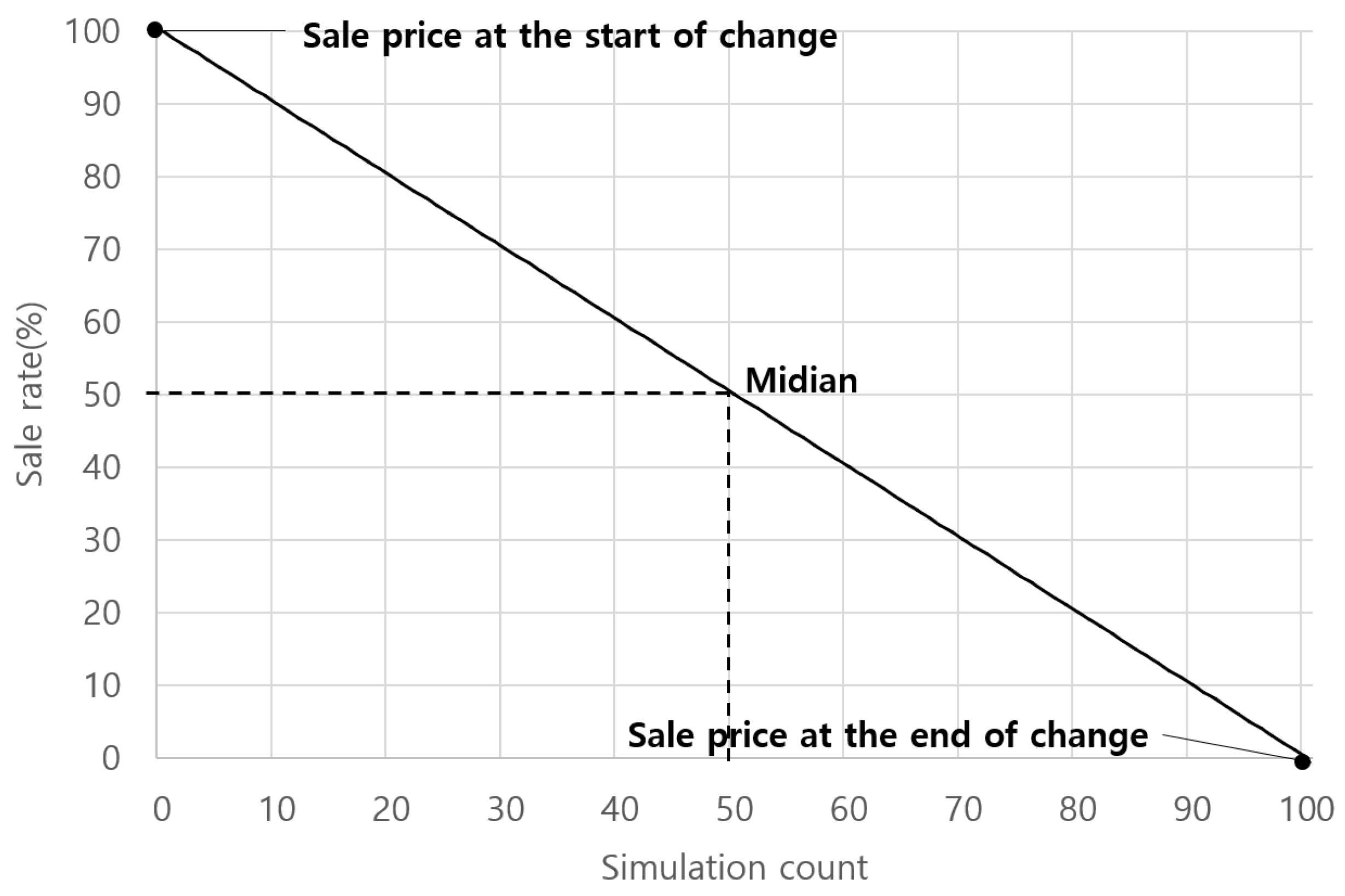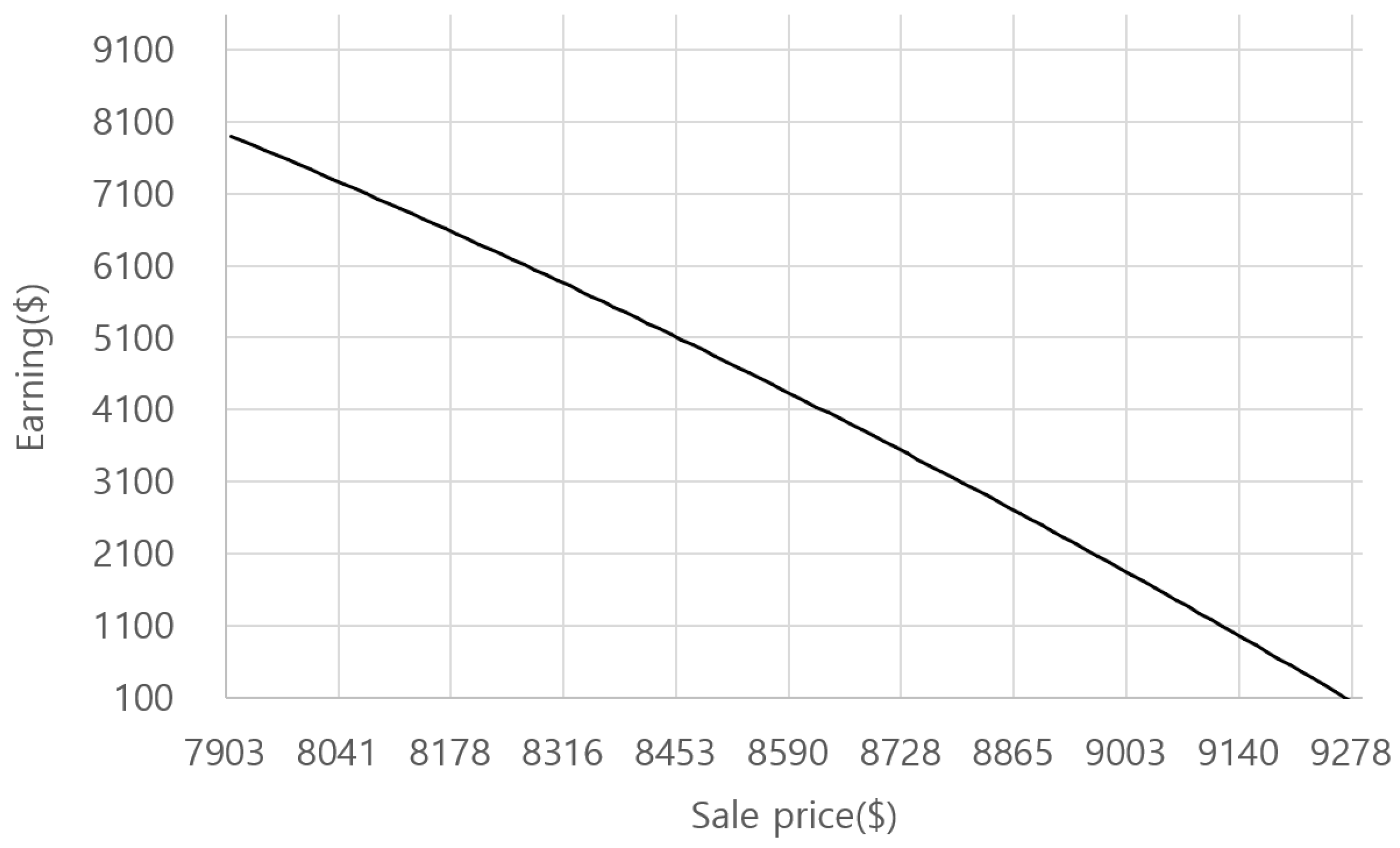3.1. Deriving the Relation between Pre-Sale Prices and Pre-Sale Rate
Generally, there are various factors affecting the pre-sale rate of apartments and the impact of each factor on the sale rate (pre-sale rate) is thought to be too complicated. This concept is reflected on the study of Park to discuss various factors [
10]. However, the current study suggests a different notion that the pre-sale prices can control the pre-sale rate completely. This can be proven by a simple example. Generally, the price-demand curve of apartments estimates a 100% demand with a sufficiently low price and the demand begins to decrease at a certain price and reaches 0% at another price. Therefore, the correlation between pre-sale prices and pre-sale rate is thought to be similar to
Figure 2 and it would not be the maximum revenue of constructors if high sales rates are achieved with a low pre-sale price at Point A or with a high pre-sale price at Point C. The construction company can achieve the maximum revenue by achieving the target sale rate with an appropriate pre-sale price at Point B.
If the estimated pre-sale rate is low considering the above factors from a company’s perspective, it means that the apartments are not meeting the buyers’ purchase desire and the profit rate is also low. The company would need to reconsider the feasibility of business and minimize financial losses by doing so. Therefore, calculating the optimum pre-sale price would reduce the loss of construction economy, lessen the number of unsold apartment units, and prevent the bankruptcy of companies, among many other positive effects.
The current study is different from the preceding studies as stated in
Figure 3. All preceding studies handled the pre-sale price as one of the many variables that affect the pre-sale rate. However, the current study assumed that the pre-sale price is the only independent variable affecting the pre-sale rate and all other variables decide the graph sale rates by sale prices. The pre-sale rate is determined by the pre-sale price only and all other variables shift the graph of estimated pre-sale rates by pre-sale prices in
Figure 2 horizontally along the X axis. If each condition of an apartment complex relatively excels the condition of another apartment complex, the graph shifts to the + direction, and vice versa. In other words, buyers are likely to pay higher pre-sale prices to purchase the apartments if the apartments offer more favorable conditions, and vice versa. All other variables both shift the graph of pre-sale prices and pre-sale rates and affect each other, and the arrow means that the factor located at the start point of the arrow affects the factor located at its end point.
3.2. Deriving the General Apartment Demand Curve
The current study excerpted the study of Park to calculate the pre-sale prices of apartments [
14]. Park [
14] used PSM (Price Sensitivity Method) to determine the rate buyers wish to pay for national lease housing.
Figure 4 indicates the results of Park’s study [
14] on the correlation between the pre-sale prices of apartments and the pre-sale rates using the UTP (Unique Target Point) method. Park estimated that the cumulative probability is 0% if the price is 2424 USD per 1 m
2, 50% if the price is 1985 USD per 1 m
2, and 100% if the price is 1758 USD per 1 m
2. The current study focused on the range where the UTP demand curve fluctuated. As a result of analyzing the graph, the demand curve showed a radical decrease in demand probability at 1858 USD per 1 m
2 and only a moderate decrease from 2182 USD. The current study defines the range of radical fluctuation as the variable section.
As shown in
Figure 4, the study’s apartment demand estimation curve begins to change at 1848 USD/m
2 and the probability of demand derived was 95.21% when analyzed by linear regression. Also, the demand probability was 0% at 2166 USD/m
2, so the variable sector of the demand curve would be from 1848 USD/m
2 to 2166 USD/m
2. The median of the variable section is 2007 USD/m
2 and the demand probability was 47.60% as a result of the linear regression analysis. The difference between the start and end points was 317 USD/m
2 and it is at 15.81% of the median, which is 2007 USD/m
2. Therefore, the pre-sale prices will fluctuate within 15.81% of the median.
3.3. Correlation Analysis
Through literature review and expert advice, the current study identified the total level of apartments, number of complexes, retail and amenities, public transportation, education, underdeveloped area, and local rates as the factors affecting the apartments. Then, the study analyzed the correlation between each factor and the pre-sale prices of apartments. As there were too few samples of data from the pre-sale prices of apartments currently in the market, the pre-sale prices per m
2 was surveyed for the apartments that are already sold. The study surveyed the actual prices of 70 apartments located in Gangnam-gu, Gangdong-gu, and Gangbuk-gu in Seoul that were traded in September 2019 based on the data disclosed by the Ministry of Land, Infrastructure, and Transport [
15]. Also, the real estate information provided by N Website was used to survey the total level of apartment buildings, number of households, and number of complexes, which were the factors not included in the data provided by the Ministry of Land, Infrastructure, and Transport. Local underdeveloped area was surveyed by excerpting the study of Oh [
11]. Oh classified the type of development level Seoul into developed, growing, depressed, and retarded as in
Table 1 based on the housing survey results announced by the Ministry of Land, Infrastructure, and Transport in 2016.
The unit prices (per m
2) of apartments surveyed in the study and the descriptive statistics chart of each item are indicated in
Table 2, and the distance to the nearest superstore from each apartment was surveyed by 0.1 km to survey the retail and amenities. In case of public transportation, the distance to the nearest station from each apartment was surveyed by 0.1 km and the walking distance to the nearest school was also surveyed by minute in case of education.
In this study, a Pearson Correlation Cooperative (PCC) was derived using Statistical Package for the Social Sciences (SPSS) to more accurately correlate each item with the selling price per m
2. PCC is a numerical representation of the linear correlation between two items, and the closer they are to 1 and −1, the more distinct they are.
The results of using (1) to correlate the selling price per m
2 with each item are as shown in
Table 3.
The study converted the various factors affecting each apartment into scores for the general evaluation of apartments and analyzed the correlation with the sale price per m
2. For that purpose, the study divided the minimum and maximum values of each item by 10 to rate each item between 1 and 10 (
Appendix A).
As a result of applying PCC of the unit price per m
2 for the comprehensive evaluation of each item, the correlation was 0.71 and significant, while the distribution of scores and unit prices per m
2 clearly showed that the sale prices per m
2 increased with greater comprehension scores as in
Figure 5.
Then, the study applied the number of apartment complexes, local rates, and local development level with prominent correlation with the sale price per m
2 to derive correlation.
Figure 6 indicates the comprehensive scores of the number of apartment complexes, local rates, and local development level and the dispersion of sale prices of apartments per m
2. PCC using Equation (1) was 0.83 and higher than 0.71, which was the weighted value when all the items were applied.
Data dispersion was not very wide comparing the dispersion of comprehensive scores of all items of
Figure 5 and the sale prices per m
2, manifesting that the current study’s method of calculation was more reliable. Later, the correlation with the unit price per m
2 was derived by applying the weighted value of each item to the scores of the number of apartment complexes, local rates, and local development level as in
Figure 7. Considering the importance of each item, the weighted values were 0.25, 0.50, and 0.25, respectively.
In that case, PCC was 0.83 and greater than 0.77, which was PCC when the weighted values of all items were applied, and the correlation was greater. This means that the study’s reliability was higher as with the scores that did not apply the weighted values.
3.4. Development of Pre-Sale Price Calculation Simulation Model
The current study suggested the following method to calculate the pre-sale prices that yield the greatest profit to companies.
First, the A value was set as the base price of pre-sale. The current study collected data from Seoul, so the A value was the mean sale price of Seoul. The mean pre-sale price of private apartments currently on sale in Seoul was 9651 USD per m2 and not very different from 9879 USD per m2, the mean pre-sale price of apartments sold. In order to acquire more data, the study applied the mean sale price per m2, not the mean pre-sale price per m2, as the base price of apartments as the data of apartments sold at similar periods, not the apartments currently in the market, reflect prices not affected by market.
Second, the start and end points of fluctuation, which mark the range of variable section based on the A value, were determined as in
Figure 8. As a result of examining the existing literature in
Section 3.2, it was derived that the range of variable section was 15.8% based on the A value. The pre-sale rate was 100% at the start point of fluctuation, so any pre-sale rate lower than the start point would only lower the pre-sale prices while maintaining 100% pre-sale rate. Therefore, it is meaningless to set the pre-sale price at any point below the start point of fluctuation, so the start point of fluctuation will be the minimum (min) of pre-sale prices. In case of the end point of fluctuation, the pre-sale rate will stay at 0% with any pre-sale prices greater than it. Therefore, the end point of fluctuation becomes the maximum (max) of pre-sale prices. Then, the pre-sale rate graph will be drafted according to the pre-sale prices that yield 100% pre-sale rate at the start point of fluctuation and 0% at the end point of fluctuation. The current study evaluated each factor on a scale of 1 to 10, so the score when the pre-sale price is the A Value is the price when the score is 5.5 points.
Third, each factor was evaluated and scored and to multiply the scores by each factor’s weighted value to derive the comprehensive score as in
Figure 9. The pre-sale rate graph by pre-sale prices was shifted left or right according to the comprehensive score. In other words, the pre-sale rate graph by sale prices is drawn where the start point of fluctuation shifts from min to min’ and the end point of fluctuation shifts from max to max’ with 100% pre-sale rate at min’ and 0% pre-sale rate at max’.
Finally, the X value is derived, the product of pre-sale price and pre-sale rate from the final graph in
Figure 10. The companies cannot reach the target profit when the pre-sale rate is raised with excessively low pre-sale prices or the pre-sale rate is lowered with excessively high sale prices, so incorrect calculation of pre-sale prices leads to great economic losses. Therefore, it is important to calculate the appropriate pre-sale prices that yield the greatest profit to the companies as the X value and the current study developed the following simulation to find it.
The current study developed the simulation model shown in
Figure 11 based on the method of calculation of pre-sale prices. The simulation model was Powersim.
First, the base value could be entered in ① to set the base of pre-sale price. The current study entered 9,879,000 KRW, the mean sale price of Seoul in September 2019. Then, the rate could be entered in ② to set the start and end points of variable section based on the base price in ① [
16]. The current study set the range of variable section at 15.8% of base price and the minimum rate and maximum rate were 7.9%, which was 1/2 of 15.8%, thus 0.92 and 1.08, respectively. Also, the pre-sale rate was set to start at 100% with the minimum rate and decrease down to 0% at the maximum rate after through gradual decrease in reverse proportion to the pre-sale price. Then, the score of each factor could be entered in ③ and the weighted value of each factor in ④. As a result of regression analysis of the correlation of weighted scores of the number of apartment complexes, local rates, and local development level and the sale price per m
2, the formulas in (2)–(4) were derived:
In other words, the pre-sale price of apartments increased by 3422 USD when the weighted score of the number of apartments complexes increased by 1, while it increased by 4143 USD when the weighted score of local rates increased by 1. In the case of local development level, the weighted value was 10.0 for developed, 7.5 for growing, 5.0 for depressed, and 2.5 for retarded. As the weighted value was 0.25 for retarded, the score increased by 0.625 when development level increased by level 1. When this was applied to (4), the price increased by 2892 USD when development level increased by level 1. ⑤ applied this to simulation and shifted the graph left or right according to the weighted score of each factor. Through this process, the simulation derived graph of pre-sale rate according to the pre-sale prices in ⑥. ⑦ visualizes the pre-sale rate corresponding to each sale price and the simulation system calculates the pre-sale income as in ⑧ by the product of ⑥ and ⑦. Then, the optimum sale price is derived as in ⑨ for the maximum pre-sale income. For that purpose, ⑧ was set as the target function and ⑨ was the decision-making variable. Optimization search is conducted based on the evolution search algorithm to search the optimum value of optimum sale prices to maximize the pre-sale income. The simulation was applied to derive the pre-sale price per m
2 when the scores of all factors were 5.5 and
Figure 12 indicates the sale prices derived from each time of simulation. The time of simulation is defined as one shift of graph by 1/100 from the start of fluctuation to the end of fluctuation when the start point was 0 and the end point was 100. In other words, n times of simulation simulates the shift of graph by 1/100 n times from the start of fluctuation to the end of fluctuation. The pre-sale price per m
2 increased gradually from the start point to the end point. Also, the simulation set all scores at 5.5, so the sale price per m
2 at 50th simulation 9879 USD, which was the mean sale price of Seoul.
Figure 13 shows the pre-sale rate according to the time of simulation. The sale price increased from the start point to the end point, so the pre-sale rate decreased in reverse proportion and reached 50% at 50th simulation. The pre-sale income increases in proportion to the exclusive area and number of units, so the current study ignored these factors and set the pre-sale income as the sale price per m
2 multiplied by the pre-sale rate.
The pre-sale income of apartments according to each sale price is as indicated in
Figure 14. The pre-sale income graph according to sale prices drew a curve of moderate declivity. The pre-sale rate was 100% when the sale price was 9089 USD for the highest pre-sale income of 9089 USD, and this means that the optimum sale price of apartments was 9089 USD.
After the simulation, the study additionally adjusted the coefficient that becomes the standard of weighted score of each factor. Previously, each factor was evaluated on a scale of 1 through 10, so the median of 5.5 was multiplied by 0.50, 0.25, and 0.25, which are the weighted values of local rates, local development level, and the number of apartment complexes, respectively, for the simulation of range of fluctuation derived by applying 2.75, 1.38, or 1.38. As a result of the simulation, there was a large error between the estimated pre-sale prices and the actual sale prices when the standard values were used, so the current study adjusted the standard value of each item to 1.01, 1.94, or 0.85 to finalize the simulation. The results of estimating the sale prices based on the simulation of apartments sold are in
Table 4. The minimum error rate of simulation was 0.12% and the maximum error rate was 24.71% with a standard deviation of 10.32% as a result of the simulation. When compared to the previous simulation, the adjusted simulation reduced the error between all apartments’ actual sale prices and the results of simulation.
As a result of the simulation, there were apartments whose appropriate sale prices were lower or higher than the actual sale prices. In the case of the apartments whose appropriate sale prices were higher than the actual sale prices, it is assumed that the apartments were traded at lower prices because the buyers overlooked the outstanding environment and value of apartments traded. On the other hand, the apartments whose appropriate sale prices were lower than the actual sale prices were probably traded due to overestimation of the actual apartments based on the buyers’ personal value.
The simulation developed by the current study is expected to contribute to increasing the profitability of apartment constructors and preventing economic losses. However, the study had a few limitations. First, it is the limitation of survey data. The current study was conducted to examine the correlation between various factors and the sale price per m2 of apartments. The study surveyed 70 apartments sold in Seoul in September 2019, but the factors selected in the study were not significantly correlated with the sale price per m2 except for a few. This is probably because the number of data gathered for the study were scarce, so a greater pool of data would be needed to draw the conclusion that many items affect the sale price per m2. The current study could not consider the special variables such as the speculators. Therefore, the simulation of the study could be improved if more factors affecting apartments are selected in future studies.
Second, it is the weighted values of factors. The study selected seven factors affecting the sale prices of apartments to set the weighted values. However, the factors with no correlation were excluded along the course of study to make it impossible to set the accurate weighted value for each factor. For that reason, the study assigned random weighted value to each factor and it had significant impact on the results of study. Therefore, it would be possible to calculate the sale prices close to the optimum sale prices when accurate weighted values are derived from future studies.
Finally, it is the incorrect range of variable section. The study excerpted a preceding study to set the range of fluctuation of presale rate estimation curve according to sale prices. As a result, the range of variable section was set at 15.8% based on the base price. This value is realistically too small to change people’s purchase desires, so an accurate range of variable section would be able to derive more reliable sale prices through future studies.
